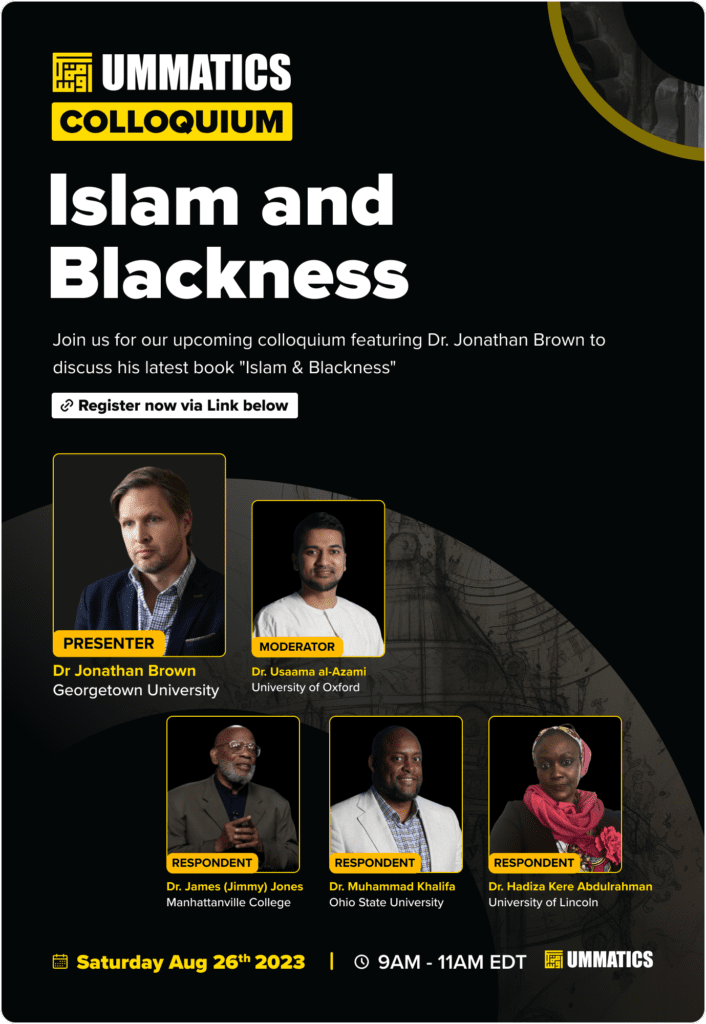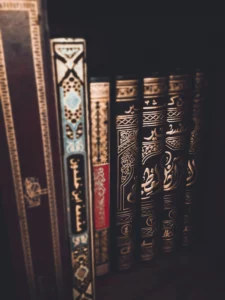
Ummatics Colloquium: Islam and Blackness
Summary
Our August 2023 colloquium featured Dr. Jonathan AC Brown, who presented on his latest book Islam and Blackness, published by Simon and Schuster in 2022. The event was moderated by Dr. Usaama Al-Azami and paneled by Dr. James Jones and Dr. Muhammad Khalifa who served as respondents.
The book is a continuation of Brown’s previous book Islam and Slavery and was written in response to an ongoing debate about whether Islam is anti-Black at the level of scripture and hadith. While there are other books that cover this question, Brown says they do not deal with many contextual problems and his book was written in an attempt to fill gaps in the existing literature.
Brown begins by questioning why Western discourses on Islamic slavery and anti-Blackness frequently emerge today, and why certain writers and figures in the West wish to insist that these issues are seldom addressed in the Arab and Muslim world. He explains that there are broadly three reasons for why these concerns are frequently articulated.
The first reason has to do with a historical anxiety over the Muslim slaver enslaving the European. This goes back to the general Western European experience with slavery from the 1500s – 1700s, when Muslim pirates off the coasts of Morocco, Algeria, and Tunisia would raid and capture European ships and take people captive as slaves to ransom them back to their families. This becomes a big feature of Western European cultural imagination. Concern with the Muslim slave trade was also a major concern. After abolitionist activists in Britain and the Americas succeeded in ending the Atlantic slave trade in the early 1800s, their attention turned to the only other slave trade, which is what they called the “Mohammedan slave trade.” This becomes the main focus of abolitionist energy after the 1830s, and the idea was that this was the only remaining source of slavery in the Afro-Eurasian world.
The second reason has to do with the rise of Afro-centrist ideas and Black nationalist movements in the United States, which started to identify with an imagined African past that was partly destroyed by the figure of the Muslim slaver. These movements adopted the idea that the Arab-Muslim slaver is, like the White Christian in America, an enemy who threatened and destroyed African civilization. This can be seen, for example, in the book The Destruction of Black Civilization by Chancellor Williams published in 1971. In this cultural imaginary, Muslims and Islam are completely foreign to Africa and they are colonial destroyers.
The third reason has to do with pro-Israel hasbara or public diplomacy from the 1960s onward. These discourses clearly have an interest in stoking the idea of Muslims and Arabs being anti-Black and slavers because it fragments third-world solidarity against Western forces of settler-colonialism, and it positions Zionists as anti-racist and Arabs and Muslims as racist. In the present, most published articles and works that question why we do not speak more about the problem of Arab and Muslim slavery are largely coming from two camps: “West-is-best” chauvinists, and self-identified Zionists or pro-Israel figures.
In response to these claims, Brown says that a robust engagement with the issues of Arab and Islamic slavery means we have to contend with a range of inaccuracies that stem from ideas about Islam and what it is, Arabs and who they are, and Africa and what it is. He claims that many of the current discourses on Arab and Islamic slavery do not seriously wrestle with questions about whether Christian slavers who later convert to Islam count as part of the phenomenon of Islamic slavery, as well as the issue of Islamic enslavement of African Muslims. Additionally, Brown argues we have to think about how our conceptions of color and race emerge in history, including who comes up with the categories of Blackness and Whiteness and why this happens in the first place.
Brown addresses these questions in his book and how these categories are engaged with in Islamic history. He claims that Arab culture during the time of the Prophet Muhammad largely used “blackness” as the marker of an outsider rather than a particular skin color. While we often hear about the famous companion Bilal being black, we do not hear about how other major figures including Amr ibn Al-As or Sufyan ibn-Umayyah being black even though they are. The reason for this is because the latter figures are not “outsiders,” even though they resemble Bilal.
Brown concludes by noting that when Muslims spread out into the greater Mediterranean world, they certainly inherited many of the racial stereotypes from Greco-Roman culture as well as the Biblical tradition. While anti-Blackness was and is a real phenomenon in Islamic civilization, Brown argues it is not essential but rather incidental. This is partly evinced by the rejection of anti-Black discourses by major historical figures such as Ibn Khaldun, Al-Suyuti, and Ibn Al-Jawzi among others. Additionally, while in certain forms of Islamic law anti-Black discourses can be seen, as in the Maliki injunction that Black women do not have to veil because they are not attractive, Brown argues this is just an expression of custom and not an essential feature of that law. This claim is supported by the fact that Maliki understandings of this issue were rejected by others; in Mecca from the 1500s – 1900s, there was a pervasive idea that Ethiopian women were the most prized and beautiful women.
Responses
Dr. James Jones responds to Brown’s presentation by noting that the book is provocative and intellectually inclusive. He argues that being intellectually provocative is part of the Prophetic tradition, and being provocative in the service of learning is important because it invites people into important discussions. Jones also notes that to argue that anti-Blackness of the past and present are the same thing is intellectually lazy and leads us to places that do not make sense. He says that Brown’s book helps to unpack the reality that the issue of anti-Blackness is more complex than contemporary popular discourses suggest.
Jones continues by mentioning that some sources were notably missing from Brown’s book, including any mention or discussion of Ibram X. Kendi’s book How to Be an Anti-Racist. The other book Jones says he would have liked to see in Brown’s book is Gordon Allport’s The Nature of Prejudice. This book is a place to start in terms of dealing with some of the impact of racism and anti-Blackness on a personal level.
Following Jones, Dr. Muhammad Khalifa responded to Brown’s presentation by claiming it is a great contribution, especially in its theorization of Blackness and anti-Blackness in conversation with the history of Islam. Khalifa says the book does a great job dispelling the idea that the Prophet Muhammad and Islam as a tradition are essentially anti-Black.
At the same time, Khalifa proposes that we think critically about a few questions regarding the book and its presentation of anti-Blackness. This includes the question of whether defending rather than simply criticizing certain Arab attitudes about Blackness is productive. Additionally, Khalifa notes that he would have liked to see a more robust discussion of Whiteness in the book given its historical entanglement in the very notion of Blackness.
Another question Khalifa raises is whether Brown’s history of anti-Blackness helps to explain the subtractive and dehumanized view of Black Muslims in the Muslim community today, suggesting we need an independent investigation of this issue. Khalifa also proposes that we need to think about how the lack of understanding and recognition of Black epistemologies and Black ways of being can also be forms of anti-Blackness as well.
The last issue Khalifa raises has to do with power and cultural spaces, especially in masjids where contradictions between stated beliefs about egalitarianism and lived practices of discrimination often manifest. Channeling Sherman Jackson, Khalifa asks whether anti-Blackness can be seen as a form of kufr in itself, and suggests that contemporary discussions of anti-Blackness need to engage more seriously and explicitly about questions such as this one.
Discussion
Brown: It is important to recognize that for some people racism does not have to do with intention, it has to do with proximity to a certain system. There are two different definitions of racism at play today and we need to think about both.
Brown: For most pre-modern Muslims, blackness is merely a description. After the 1200s, it takes a turn and becomes a pejorative categorization.
Brown: Although we should engage with the concept of Whiteness, I do not support any positive conception of Whiteness. It is a largely negative confederate construction intended to “other” certain groups.
Brown: Mosques in the U.S. should cede leadership to Black Muslims for the good of our community and its protection as well as other anti-racist reasons.
Al-Azami: In general, there is a recognition that racism is a central or important issue throughout the modern Umma. What is the role of racism in an Ummatic context? If we want to revive solidarity among billions of Muslims, how do divisions of ethnic, linguistic, and racial proportions present a problem?
Jones: If you are part of the Muslim community, you have an obligation to understand the scope of the problem of racism. Understanding that Blackness today is different from Blackness even fifty years ago is part of that obligation, for example, but Muslims need to also understand that Blackness can be and is used as a dehumanizing categorization.
Khalifa: Where is the Islamic response to anti-Blackness in the post-colonial moment? Whiteness in the contemporary moment is a normalized and invisibilized marker. Comparable behaviors between White and Black individuals are treated differently. Why is that? Our Islamic tradition can and does speak to this but we need to do more to address it more directly.
Brown: The problem in America is that the White norms of ‘urf are the ruling ones and everyone is expected to adopt to that. People who “become” white are ultimately accepted, like Italians. Black people will not be accepted in a similar way. The problem in the Muslim community is not simply that there is anti-Blackness, it is that we all accept White supremacy as a culture and a setting. Successful suburban Desis and Arabs in America act like White people. Their polestar is the idea of Whiteness, and it even informs their idea of what it means to be a good Muslim.
Al-Azami: When we’re talking about Whiteness, we are not talking about a phenotype but a civilizational attitude. In order for Muslims to assimilate in America, they must adapt to certain civilizational imperatives.
Khalifa: Many young Muslims are against White supremacy but are not willing to take up the issue of immigrant supremacy in public Muslim spaces.
Jones: The classroom and the street are different. It is one thing to talk about the problem of anti-Blackness and White supremacy in the classroom, where everything is up for grabs. Actions and models of acting are a different story.
Jones: We also need to think about how racism and sexism are twins. If we are going to move forward, we need to think about how these two phenomena are intertwined.



